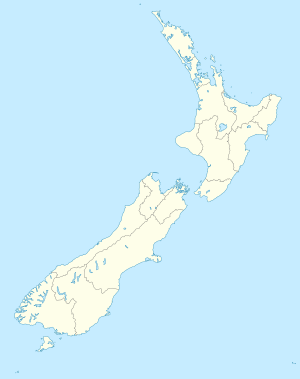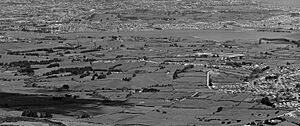Botany Downs facts for kids
Quick facts for kids
Botany Downs
|
|
|---|---|
|
Suburb
|
|
| Country | New Zealand |
| Local authority | Auckland |
| Electoral ward | Howick ward |
| Local board | Howick Local Board |
| Area | |
| • Land | 170 ha (420 acre) |
| Population
(June 2023)
|
|
| • Total | 5,830 |
|
|
||
Botany Downs is an eastern suburb of the city of Auckland, New Zealand. This residential area previously formed part of the East Tāmaki area. In terms of local-body administration, the suburb lies in the Howick ward, one of the thirteen administrative divisions of the Auckland Council.
Geography
Botany Downs is located in the central peninsula of East Auckland, between the Tāmaki River and Tāmaki Strait of the Hauraki Gulf. The suburb is south of Howick. Botany Creek runs west through the suburb to meet the Pakuranga Creek. The soil around Howick is primarily clay and sandstone. Botany Road is a major arterial road that runs north-south through Botany Downs, which intersects with Cascades Road to the south of the suburb.
History
Early history
The Botany Downs area is part of the rohe of Ngāi Tai ki Tāmaki, who descend from the crew of the Tainui migratory waka, who visited the area around the year 1300. Ōwairoa is the traditional name used to describe the swampy inland areas away from the coast. The wider area was extensively cultivated, but as the area was relatively exposed, two fortified pā were constructed: Paparoa Pā at the south-eastern end of Waipaparoa / Howick Beach, and Tūwakamana Pā above Cockle Bay. During the Musket Wars in the 1820s, Ngāi Tai Ki Tāmaki sought temporary refuge in the Waikato. When English missionary William Thomas Fairburn visited the area in 1833, it was mostly unoccupied.
In 1836, William Thomas Fairburn brokered a land sale between Tāmaki Māori chiefs covering the majority of modern-day South Auckland, East Auckland and the Pōhutukawa Coast. The sale was envisioned as a way to end hostilities in the area, but it is unclear what the chiefs understood or consented to. Māori continued to live in the area, unchanged by this sale. In 1854 when Fairburn's purchase was investigated by the New Zealand Land Commission, a Ngāi Tai reserve was created around the Wairoa River and Umupuia areas, and as a part of the agreement, members of Ngāi Tai agreed to leave their traditional settlements to the west.
In 1847, Howick was established as a defensive outpost for Auckland, by fencibles (retired British Army soldiers) and their families.
Development of the suburb
Botany Downs was the name of a farm leased by Vern Carr from James Wilson. Carr named the farm after Botany Road. The "Downs" in the name was not a reference to the geography of the area, instead a reference to the economics of farming in the 1950s and 1960s. The area was developed into suburban housing in the mid-1970s, and Botany Downs Primary School opened in 1975. The school decided to name itself after Carr's former farm, a fact that displeased Carr.
In 1984, the Howick Club, a private social club, opened in Botany Downs, and in 1989 a new bridge on Botany Road was constructed over the Botany Creek. In the year 2000, a 153 unit condominium development called Sacramento was constructed in Botany Downs. The development was part of the leaky homes crisis, and led to a multi-million dollar lawsuit by the occupants.
Demographics
Botany Downs covers 1.70 km2 (0.66 sq mi) and had an estimated population of 5830 as of June 2023, with a population density of 3429 people per km2.
| Historical population | ||
|---|---|---|
| Year | Pop. | ±% p.a. |
| 2006 | 4,800 | — |
| 2013 | 4,860 | +0.18% |
| 2018 | 5,154 | +1.18% |
Before the 2023 census, Botany Downs had a smaller boundary, covering 1.49 km2 (0.58 sq mi). Using that boundary, Botany Downs had a population of 5,154 at the 2018 New Zealand census, an increase of 294 people (6.0%) since the 2013 census, and an increase of 354 people (7.4%) since the 2006 census. There were 1,680 households, comprising 2,496 males and 2,658 females, giving a sex ratio of 0.94 males per female, with 975 people (18.9%) aged under 15 years, 921 (17.9%) aged 15 to 29, 2,457 (47.7%) aged 30 to 64, and 804 (15.6%) aged 65 or older.
Ethnicities were 60.5% European/Pākehā, 5.1% Māori, 3.1% Pacific peoples, 35.2% Asian, and 3.6% other ethnicities. People may identify with more than one ethnicity.
The percentage of people born overseas was 49.4, compared with 27.1% nationally.
Although some people chose not to answer the census's question about religious affiliation, 46.6% had no religion, 39.3% were Christian, 0.2% had Māori religious beliefs, 2.4% were Hindu, 1.3% were Muslim, 1.9% were Buddhist and 2.2% had other religions.
Of those at least 15 years old, 1,188 (28.4%) people had a bachelor's or higher degree, and 504 (12.1%) people had no formal qualifications. 906 people (21.7%) earned over $70,000 compared to 17.2% nationally. The employment status of those at least 15 was that 2,253 (53.9%) people were employed full-time, 525 (12.6%) were part-time, and 120 (2.9%) were unemployed.
| Name | Area (km2) |
Population | Density (per km2) |
Households | Median age | Median income |
|---|---|---|---|---|---|---|
| Botany Downs West | 0.81 | 2,862 | 3,533 | 900 | 39.4 years | $37,600 |
| Botany Downs East | 0.68 | 2,292 | 3,371 | 780 | 39.0 years | $39,700 |
| New Zealand | 37.4 years | $31,800 |
Education
Botany Downs School is a contributing primary school (years 1–6) with a roll of 527. Elim Christian College is a state-integrated Christian composite school (years 1–13) with a roll of 859. All these schools are coeducational. Rolls are as of February 2024. The main secondary schools for the area are Botany Downs Secondary College and Howick College.



